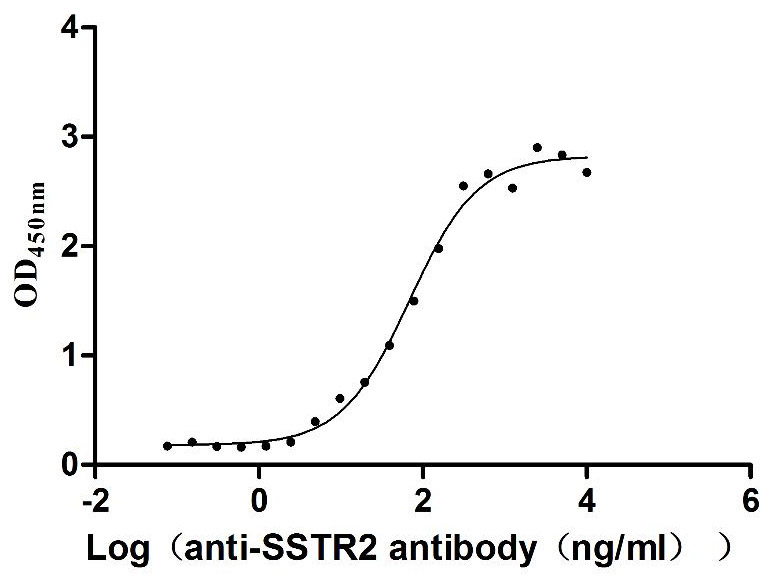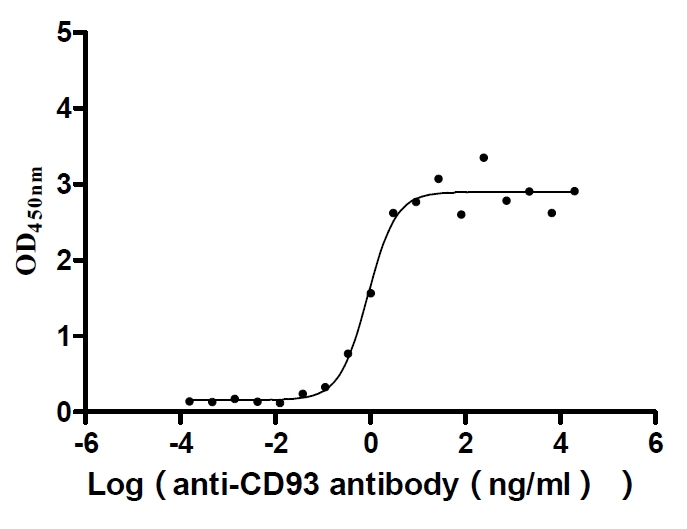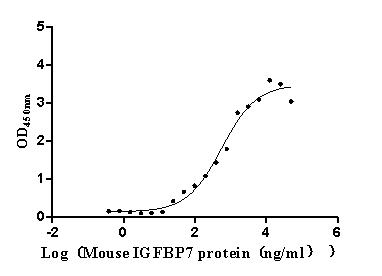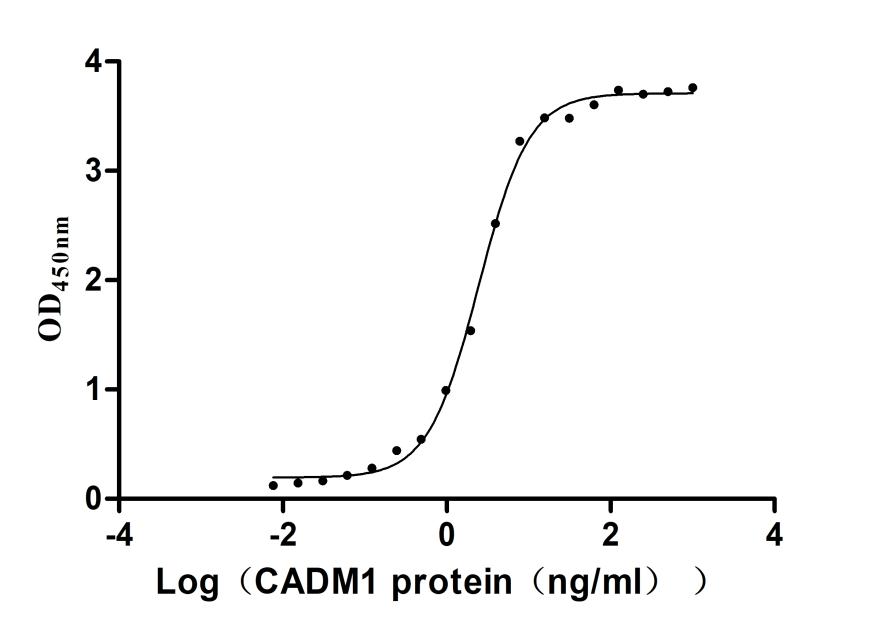Recombinant Mouse Steroidogenic acute regulatory protein, mitochondrial (Star)
-
中文名稱:小鼠Star重組蛋白
-
貨號:CSB-YP022798MO
-
規(guī)格:
-
來源:Yeast
-
其他:
-
中文名稱:小鼠Star重組蛋白
-
貨號:CSB-EP022798MO
-
規(guī)格:
-
來源:E.coli
-
其他:
-
中文名稱:小鼠Star重組蛋白
-
貨號:CSB-EP022798MO-B
-
規(guī)格:
-
來源:E.coli
-
共軛:Avi-tag Biotinylated
E. coli biotin ligase (BirA) is highly specific in covalently attaching biotin to the 15 amino acid AviTag peptide. This recombinant protein was biotinylated in vivo by AviTag-BirA technology, which method is BriA catalyzes amide linkage between the biotin and the specific lysine of the AviTag.
-
其他:
-
中文名稱:小鼠Star重組蛋白
-
貨號:CSB-BP022798MO
-
規(guī)格:
-
來源:Baculovirus
-
其他:
-
中文名稱:小鼠Star重組蛋白
-
貨號:CSB-MP022798MO
-
規(guī)格:
-
來源:Mammalian cell
-
其他:
產(chǎn)品詳情
-
純度:>85% (SDS-PAGE)
-
基因名:
-
Uniprot No.:
-
別名:Star; Steroidogenic acute regulatory protein; mitochondrial; StAR; Luteinizing hormone-induced protein; START domain-containing protein 1; StARD1
-
種屬:Mus musculus (Mouse)
-
蛋白長度:Full Length of Mature Protein
-
表達區(qū)域:-
-
蛋白標簽:Tag?type?will?be?determined?during?the?manufacturing?process.
The tag type will be determined during production process. If you have specified tag type, please tell us and we will develop the specified tag preferentially. -
產(chǎn)品提供形式:Lyophilized powder
Note: We will preferentially ship the format that we have in stock, however, if you have any special requirement for the format, please remark your requirement when placing the order, we will prepare according to your demand. -
復溶:We recommend that this vial be briefly centrifuged prior to opening to bring the contents to the bottom. Please reconstitute protein in deionized sterile water to a concentration of 0.1-1.0 mg/mL.We recommend to add 5-50% of glycerol (final concentration) and aliquot for long-term storage at -20℃/-80℃. Our default final concentration of glycerol is 50%. Customers could use it as reference.
-
儲存條件:Store at -20°C/-80°C upon receipt, aliquoting is necessary for mutiple use. Avoid repeated freeze-thaw cycles.
-
保質期:The shelf life is related to many factors, storage state, buffer ingredients, storage temperature and the stability of the protein itself.
Generally, the shelf life of liquid form is 6 months at -20°C/-80°C. The shelf life of lyophilized form is 12 months at -20°C/-80°C. -
貨期:Delivery time may differ from different purchasing way or location, please kindly consult your local distributors for specific delivery time.Note: All of our proteins are default shipped with normal blue ice packs, if you request to ship with dry ice, please communicate with us in advance and extra fees will be charged.
-
注意事項:Repeated freezing and thawing is not recommended. Store working aliquots at 4°C for up to one week.
-
Datasheet :Please contact us to get it.
靶點詳情
-
功能:Plays a key role in steroid hormone synthesis by enhancing the metabolism of cholesterol into pregnenolone. Transporter that binds to and transport cholesterol through the intermembrane space of the mitochondrion.
-
基因功能參考文獻:
- The present study revealed that StAR overexpression can reduce hepatic lipid accumulation, regulate glucose metabolism and attenuate insulin resistance through a mechanism involving the activation of FXR. PMID: 28153708
- studies suggest that miR-150 negatively regulates the expression of STAR and steroidogenesis of Leydig cells in mice PMID: 28611112
- melatonin not only elevated progesterone (P) secretion, but also upregulated expressions of StAR and Cyp11a1 and also had an increased Ihh expression in endometrium. PMID: 28749439
- The data suggest that STMN1 mediates the progesterone production by modulating the promoter activity of Star and Cyp11a1. PMID: 27270953
- StAR may activate PPARgamma by increasing UFAs, which leads to a protective role in systemic inflammation and insulin resistance in obese mice. PMID: 28402022
- ChIP results confirmed the binding of NRF1 to StAR promoter region. In conclusion, decline of NRF1 expression downregulated the level of StAR, which ultimately resulted in a reduction in testosterone synthesis. PMID: 28146428
- target of the microRNA let-7, which itself is regulated by the long noncoding RNA H19 PMID: 27813675
- The results demonstrated that ZnT7 gene silencing downregulated the expression of StAR, P450scc and 3beta-HSD as well as progesterone concentrations in the human chorionic gonadotrophin-stimulated Leydig tumor cells. PMID: 27121848
- Chronic exposure to low-dose perfluorooctane sulfonate selectively reduces histone acetylation of StAR and suppresses the biosynthesis of E2 to impair the follicular development and ovulation. PMID: 26358002
- cAMP, SIK and CRTC mediate StAR expression through activation of individual StAR gene loci. PMID: 25662274
- Bisphenol A induces oxidative stress by altering the expression of iNOS, which consequently leads to the down regulation of StAR expression in the testis of male mouse PMID: 25569322
- Results show that HIF1alpha appears to be a positive regulator of basal and stimulated STAR-expression, which under partial hypoxia is capable of increasing the steroidogenic capacity of granulosa cells. PMID: 25478925
- Deletion of the START domain from Arabidopsis Glabra2, a representative HD-Zip transcription factor, results in a complete loss-of-function phenotype. The mammalian START domain from StAR can functionally replace the HD-Zip-derived START domain. PMID: 25159688
- Despite StAR protein expression comparable to amounts seen with control animals or rescue with WT StAR, S194A StAR did not rescue the neonatal lethality and only partially rescued the sex reversal in male mice observed uniformly in StAR knockout mice. PMID: 24850413
- These discoveries highlight the importance of mitochondrial fusion and ERK phosphorylation in cholesterol transport by means of directing StAR to the outer mitochondrial membrane. PMID: 24945345
- Postinfarction expression of nonsteroidogenic StAR in cardiac fibroblasts has novel antiapoptotic activity. PMID: 23831818
- Data indicate that macrophages exhibited a strong time-dependent induction of mitochondrial StarD1 and plasma membrane ABCA1, which exports cholesterol. PMID: 24269887
- StAR immunoreactivity is detected during the first steps of testis differentiation. PMID: 23522077
- Data suggest that the regulation of StAR by transcription factors including SF-1, GATA-4 and C/EBP-beta maybe critical mechanism involved in low-dose MBP-stimulated steroidogenesis. PMID: 23889939
- Ch itself, 7alpha-OOH can be transported to/into Mito of steroidogenic cells by StAR proteins and therein induce free radical damage, which compromises steroid hormone synthesis PMID: 23467407
- Sodium fluoride inhibited expression of StAR and P450scc in mouse Leydig tumor cells, which inhibited progesterone secretion. PMID: 22443068
- HSL acts to drive cAMP/PKA-mediated regulation of StAR expression and steroidogenesis in mouse Leydig cells. PMID: 23362264
- A significant 24-h rhythmic variation in the adrenal Star mRNA expression and circulating corticosterone concentration was similarly phase-advanced during the L/D cycle in VPC2(-) mice. PMID: 22622901
- The calcium signaling pathway regulates leydig cell steroidogenesis through a transcriptional cascade involving the nuclear receptor NR4A1 and the steroidogenic acute regulatory protein. PMID: 23183170
- Data show that in steroidogenic acute regulatory protein knockout Star(-/-) mice, expression levels of genes involved in cholesterol efflux and the inflammatory response were significantly up-regulated. PMID: 22529212
- Data show that binding motifs of 14-3-3gamma were identified in components of the transduceosome, including STAR. PMID: 22427666
- Prenatal exposure to ethanol increased expressions of StAR and P450scc in maternal adrenal and decreased them in fetal adrenal. PMID: 20627497
- levels of StAR protein and progesterone production were downregulated in the presence of Star NAT. Our data identify antisense transcription as an additional mechanism involved in the regulation of steroid biosynthesis PMID: 21829656
- Cox7a2 decreased P70S6K phosphorylation, reduced StAR expression and consequently inhibited LH-induced testosterone biosynthesis in the TM3 Leydig cells. PMID: 21548202
- Gonadotropin-regulated testicular RNA helicase (GRTH/DDX25), a negative regulator of luteinizing/chorionic gonadotropin hormone-induced steroidogenesis in Leydig cells: central role of steroidogenic acute regulatory protein (StAR). PMID: 21719703
- Apigenin interrupted COX2-dependent signaling by increasing StAR gene expression and steroidogenesis in mouse Leydig cells. PMID: 20537519
- Vasoactive intestinal peptide strognly upregulated STAR expression and steroidogenesis. PMID: 20655982
- Data show that GX sPLA(2) is expressed in mouse adrenal glands and functions to negatively regulate corticosteroid synthesis, most likely by negatively regulating StAR expression. PMID: 20421306
- Perfluorododecanoic acid inhibits steroidogenesis in cAMP-stimulated Leydig cells by reducing the expression of StAR through a mode of action involving oxidative stress. PMID: 20100736
- Macrophage overexpression of StAR significantly enhances LXR-dependent apoAI- and ABCA1-dependent cholesterol efflux. PMID: 20083572
- Pubertal Cd exposure markedly reduced mRNA and protein levels of testicular StAR, P450scc, P450(17alpha) and 17beta-HSD in mice. PMID: 19897027
- StAR mRNA levels were significantly lower in stressed Leydig cells than that in controls. PMID: 19462908
- These findings extend our understanding of steroidogenic cell dysfunction in StAR KO mice and highlight key roles of trophic hormones and high-density lipoprotein-derived cholesterol in lipid deposits within StAR-deficient steroidogenic cells. PMID: 12351695
- These findings provide novel insights into the mEGF-induced regulatory cascades associated with steroid synthesis and StAR protein expression in mouse Leydig cells. PMID: 12390868
- In mitochondria shortly after import, StAR is degraded by inhibitor-sensitive protease. At later times StAR turnover proceeds to completion through an MG132-resistant proteolytic activity. PMID: 12530639
- Oligonucleotides antisense, but not sense, to PBR and StAR reduced their respective levels in steroidogenic cells and inhibited hormone-stimulated steroid formation. PMID: 12530641
- PTP activity participates in StAR protein induction and led us to attribute to the PKA-mediated PTP activation in steroidogenic systems a functional role, as mediator of StAR protein induction. PMID: 12530643
- Short review of evidence for steroidogenesis within hypothalamic and hippocampal neurons and glia PMID: 12670729
- mutations that eliminated the binding sites of CRE and SF-1 elements, either alone or in combination, resulted in an attenuation of StAR promoter activity PMID: 12790807
- The significant reduction in the 32- to 30-kDa mature forms of StAR, cessation of cholesterol transport, and loss of Deltapsi(m) are consistent with mitochondrial perturbation because of oxidative stress. PMID: 12810543
- inhibition of cyclooxygenase 2 activity enhanced steroidogenic acute regulatory protein gene transcription and steroid production PMID: 12865315
- 5-lipoxygenase metabolites of arachidonic acid are involved in cyclic AMP-stimulated steroidogenesis and STAR protein gene expression. PMID: 12943700
- induction of StAR expression by MIS occurs secondary to the MIS-mediated reduction in testosterone synthesis by relieving a hitherto uncharacterized androgen-dependent feedback inhibition on StAR expression. PMID: 14630719
- insights into the mechanisms regulating StAR gene transcription. PMID: 14673133
- Increased StAR transcription can occur in the context of different patterns of transcription factor binding and histone modification. PMID: 14726488
顯示更多
收起更多
-
亞細胞定位:Mitochondrion.
-
組織特異性:Expressed within glia and neurons in discrete regions of the brain.
-
數(shù)據(jù)庫鏈接:
Most popular with customers
-
Recombinant Human Poliovirus receptor (PVR) (I340M), partial (Active)
Express system: Mammalian cell
Species: Homo sapiens (Human)
-
Recombinant Human Somatostatin receptor type 2 (SSTR2)-VLPs (Active)
Express system: Mammalian cell
Species: Homo sapiens (Human)
-
Recombinant Human Complement component C1q receptor (CD93), partial (Active)
Express system: Mammalian cell
Species: Homo sapiens (Human)
-
Recombinant Mouse Complement component C1q receptor (Cd93), partial (Active)
Express system: Mammalian cell
Species: Mus musculus (Mouse)
-
Recombinant Human Cytotoxic and regulatory T-cell molecule (CRTAM), partial (Active)
Express system: Mammalian cell
Species: Homo sapiens (Human)


-AC1.jpg)













